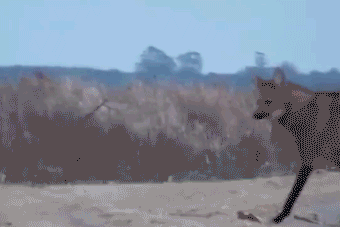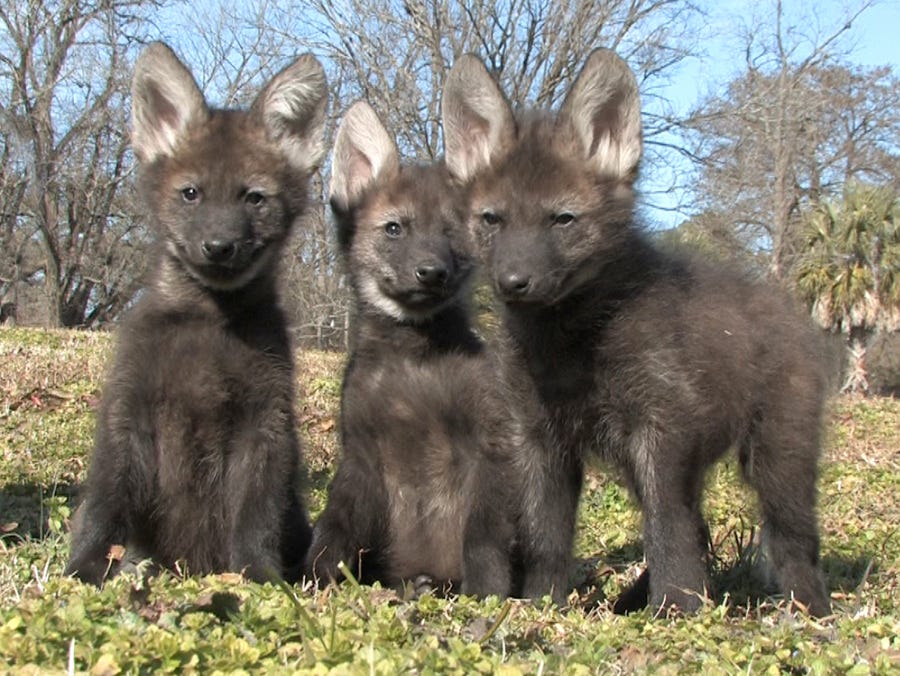Maned Wolf is Not Really a Wolf
And some of them are woman’ed wolves too! (OK, that was terrible, I apologize)
In today’s hed gif, we are watching some footage of a maned wolf, filmed by Brazil Safaris. Look at those gorgeous gams, an evolutionary adaptation that helps the maned wolf navigate the tall grasses where it lives. She is one tall drink of water, no doubt about it! I apologize for the pixelated wonkiness of the gif. It just didn’t want to compress nicely for me. You will want to watch the source vid for a bit better clarity, although I’ve also included a few other more professional videos for you to watch as well with cleaner footage.
Maned wolves are a bit misnamed. They are, in fact, not wolves. Nor are they foxes, despite their fox-like appearance. Instead they are the only members of the Chrysocyon (“golden dog” in Ancient Greek) family. They are native to central-eastern South America, living in regions covering Brazil, Bolivia, Paraguay, and bits of Argentina and Uruguay. Chrysocyon are rather unique in the canine evolutionary line: its closest evolutionary relative is the smaller bush dog of central South America, and it shares an evolutionary ancestor with the now-extinct Falkland Islands wolf, splitting off from that line about seven million years ago.
Maned wolves are omnivores. They will hunt prey animals, but they readily eat vegetable matter, such as sugarcane, roots and fruit. In fact, plant matter makes up about 50 percent of their diet. Their favorite meal is the wolf apple and they will seek out the fruit, which can be found year-round in their habitat. Their love of the fruit makes them symbiotic partners with leafcutter ants, who use the maned wolf’s fruity dung to fertilize their own fungus gardens(!!). The ants will strip the dung from seeds, leaving them in piles outside their nests, which in turn increases seed germination. Wow, talk about a highly specified symbiotic circle of life, I just love that these three organisms evolved to take advantage of that harmonious relationship.
Maned wolves do not form packs, atypical of most wild canine species. They will, however, join into a monogamous relationship and will hunt and defend shared territory with that partner. But preferring solitude, a mating pair will often only cross paths to mate, the rest of the time patroling their turf on their own. Their gestation cycle lasts for 60 to 65 days and liters of pups typically range from two to six. The pups are, as you might expect, absolutely adorable, with fuzzy black fur and those big fox-like ears.
The maned wolf uses urine marking to defend their teritory and to communicate. It is a very pungent urine, leading to the maned wolf’s nickname of “skunk wolf.” The scent is close enough to cannibus that in 2006, law enforcement was called in to Rotrterdam Zoo to investigate complaints about a visitor smoking weed, only to discover that the smell was coming from the maned wolf exhibit.
Here is the awesome Danielle Dufault from Animalogic with a rundown on this unusual animal.
And a video from the Houston Zoo, featuring those adorable puppies:




Puppy!
Such adorable puppies! Thanks! I needed that.